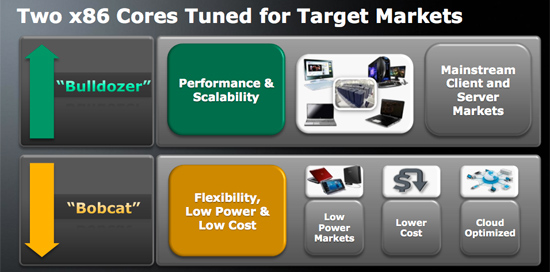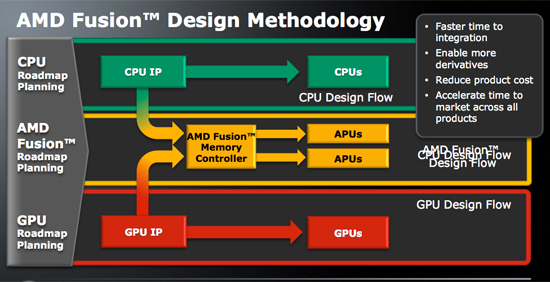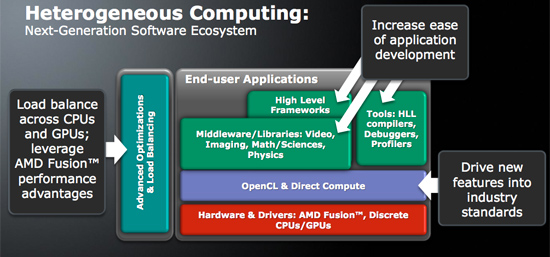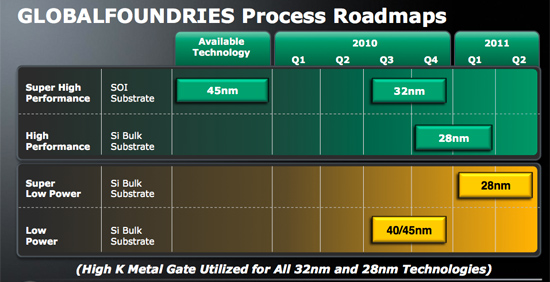AMD Unveils Bulldozer & Bobcat: 2011 Microachitectures
by Anand Lal Shimpi on November 11, 2009 5:00 PM EST- Posted in
- CPUs
I spoke too soon. Earlier today I outlined AMD’s roadmap for 2010 - 2011. In 2011 AMD will introduce two next-generation microarchitectures: Bulldozer for the high end desktop and server space and Bobcat for the price/power efficient ultra mobile market. I originally said that AMD wasn’t revealing any more about its next-gen architectures, but AMD just proved me wrong as they unveiled the first block diagrams of both cores.

First up, Bulldozer. I hinted at the architecture in this afternoon’s article:
“A major focus is going to be improving on one of AMD’s biggest weaknesses today: heavily threaded performance. Intel addresses it with Hyper Threading, AMD is throwing a bit more hardware at the problem. The dual integer clusters you may have heard of are the route AMD is taking...”
And here’s the block diagram:

Bulldozer: AMD's Latest Leap Forward, will it be another K8 to Intel's Sandy Bridge?
This is a single Bulldozer core, but notice that it has two independent integer clusters, each with its own L1 data cache. The single FP cluster shares the L1 cache of the two integer clusters.
Within each integer “core” are four pipelines, presumably half for ALUs and half for memory ops. That’s a narrower width than a single Phenom II core, but there are two integer clusters on a single Bulldozer core.
Bulldozer will also support AVX, hinted at by the two 128-bit FMAC units behind the FP scheduler. AMD is keeping the three level cache hierarchy of the current Phenom II architecture.
A single Bulldozer core will appear to the OS as two cores, just like a Hyper Threaded Core i7. The difference is that AMD is duplicating more hardware in enabling per-core multithreading. The integer resources are all doubled, including the schedulers and d-caches. It’s only the FP resources that are shared between the threads. The benefit is you get much better multithreaded integer performance, the downside is a larger core.
Doubling the integer resources but not the FP resources works even better when you look at AMD’s whole motivation behind Fusion. Much heavy FP work is expected to be moved to the GPU anyway, there’s little sense in duplicating FP hardware on the Bulldozer core when it will eventually have a fully capable GPU sitting on the same piece of silicon. While the first incarnation of Bulldozer, the Zambezi CPU, won't have an on-die GPU, presumably future APUs will use the new core. In those designs the Bulldozer cores and the GPU will most likely even share the L3 cache. It’s really a very elegant design and the basis for what AMD, Intel and NVIDIA have been talking about for years now. The CPU will do what it does best while the GPU does what it is good at.


Fascinating.
AMD’s Next-Generation Ultramobile Core: Bobcat
Next up is Bobcat:

AMD says that a single Bobcat is capable of scaling down to less than one watt of power. Typically a single microarchitecture is capable of efficiently scaling to an order of magnitude of TDP. If Bobcat can go low as 0.5W, the high end would be around 5W. If it’s closer to 1W at the low end then 10W would be the upper portion. Either way, it’s too low to compete in current mainstream notebooks, meaning that Bobcat is strictly a netbook/ultraportable core as AMD indicated in its slides. Eventually Bulldozer will probably scale down to take care of the mainstream mobile market.
AMD provided very little detail here other than it delivers 90% of today’s mainstream performance in less than half of the silicon area. If AMD views mainstream as an Athlon II X2, then Bobcat would deliver 90% of that performance in a die area of less than 60mm^2.
Clearly this is bigger than Atom, but that’s just a guess. Either way, the performance targets sound impressive. SSE1-3 are supported as well as hardware virtualization.

AMD wouldn’t tell me what process it would be made on but they did hint that Bobcat would be easily synthesizable. I take that to mean it will be built on a bulk 28nm process at Globalfoundries and not 32nm SOI.
Both of these cores will be out in 2011. We just need to make it through 2010 first.










68 Comments
View All Comments
bakerzdosen - Wednesday, November 11, 2009 - link
I'd LOVE to see AMD come out with a true Nehalem EX competitor, but it doesn't look like 2010 will really be the year where AMD leap frog's Intel. And that's too bad for all of us.yyrkoon - Wednesday, November 11, 2009 - link
Please explain to me why it is necessary for "AMD to leapfrog Intel". Well first, I suppose some clarification would also be necessary.Anyways, it is not necessary for Intel, OR AMD to lead anything. All that should matter to us consumers is that there is enough competitiveness in the market; That *we* the consumer get a good product, for a fair price. You should hope that neither go away, and both stay competitive.
strikeback03 - Thursday, November 12, 2009 - link
Might not be technically possible, but it is nice to think that if AMD were to leapfrog Intel, a) that would be a very good AMD processor; and b) Intel would respond with something on the order of the P4 to C2D jump. Whereas when Intel already holds the lead, we see the C2D to i7 jump.Indigo64 - Wednesday, November 11, 2009 - link
It's fun to see them leapfrog for sure, but I'm with the poster I'm quoting - as long as the consumer wins. I'm always for AMD AND Intel's success. I can't wait to see what each one has to bring to the table. Innovation FTW.Scali - Thursday, November 12, 2009 - link
Yea, the rules of the game are pretty simple...If AMD wins, Intel will compete on price by offering cheaper alternatives.
If Intel wins, AMD will compete on price by offering cheaper alternatives.
If they're tied, they're going for a direct pricewar, and both will have low prices.
I think in any situation, at least one of the two will be going for maximum price/performance. It doesn't really matter whether that's AMD or Intel, does it? As long as the product does what it says on the tin.
Calin - Thursday, November 12, 2009 - link
Competing on price is financially bad for the company that compete on price. Remember when AMD had the performance crown? Its products were more expensive than Intel's. That ends up with more money for the same products. As soon as Intel leapfrogged AMD, the same products were cheaper, and brought fewer money.JPForums - Thursday, November 12, 2009 - link
Funny, I seem to remember a different view of when AMD was on top. They offered a top of the line Athlon64-FX for ~$750. The clearly inferior, but competing P4- Extreme from Intel was still priced around $1000.In the mainstream, you did pay a premium for AMD chips. However, the premium wasn't that great. Consider that Intel still had to lower the prices of their offerings to compete. However, they still didn't lower prices to the point that they could be called a better value. In other words, AMD's offerings at the time had AT LEAST enough of a performance advantage to justify the premium they sought. Further, demand for the AMD chips were high enough that they couldn't always keep up with demand. It's a wonder prices didn't get significantly higher.
Now that Intel is back on top, AMD has show itself much more willing to price its products at price points that (for the most part) are justified by their performance. When Intel lowered prices to match the value of AMDs processors, AMD kept lowering prices to maintain the value advantage.
Notably, Intel's processor lineup suffers an incredible price disparity between the chips that AMD can compete with and the chips for which there is no competition. Just look at the current pricing of the Core i7 series (from newegg).
Exerts from the 900 series:
Model 920 950 975
Pricing $289 $570 $1000
or if you prefer the 800 series:
Model 860 870
Pricing $290 $550
That all said, if AMD got on top for long enough, they would eventually do the same thing. It isn't wrong of a company to charge a premium for a superior product. Of course using monopolistic and/or illegal business practices to restrict alternatives and trap people with higher costs would be wrong, but that's a different story. As it stands the price of Intel's mid-high grade offerings are competitive. If they wanted to sell more high end chips, they'd lower the prices of these chips to the point that more consumers considered it worth the money over their own mid-high grade chips. It seems that their are enough people willing to pay the premium that Intel isn't worried about it.
This is why leap frogging is important to the consumer. People are much less willing to pay premiums for chips now if they believe that you competitor will come out with something better in the near future. Just look at ATi and nVidia. nVidia had been dominant so long when the GTX 200 series chips came out that they thought they could charge $650 for the high end single GPU card and people would pay it. ATi then released a competing (not even dominant) 4800 series at a much lower cost. The next high end single GPU card nVidia release was ~$200 cheaper at launch than the previous one. If they release Fermi at $650, I seriously doubt they'll achieve consumer market penetration. Of course, Fermi seems geared towards the scientific and professional markets, so they may not care about consumer market penetration.
In the long run, you don't want a situation where one competitor is on always on top and the other is constantly competing on price either. Such a situation allows the dominant competitor to sink significant amounts of money in R&D, while the other competitor's budget dwindles and they have an increasingly hard time of keeping up. In the worst case, the dominant competitor gains patents that criple the other competitor's ability to effectively compete.
Scali - Friday, November 13, 2009 - link
The way I recall it, the FX was $1000 aswell (okay, perhaps there were two models, one $750, the other $1000).At any rate, I think Intel was in denial initially, and tried to maintain the high prices... or people just continued to pay the high prices anyway, because of Intel's stronger brand recognition.
However, when Intel launched the Pentium D, they started an all-out pricewar. They were absolute bargains. Intel repeated the trick with the quadcore. The Q6600 was being sold at very low prices, even before AMD actually had a quadcore on the market. A pre-emptive strike, if you will.
If you ask me, the Core i5 and i7 860 are priced very nicely. They're still at 'mainstream' prices, compared to what we paid a few years ago for mainstream Athlon X2s, Pentium 4/D or Core2. $200-$300 for a CPU that is hugging the outer extremes of performance is just great value.
Currently AMD is cheaper, but you take a pretty significant dip in performance compared to Core i5/i7.
You are ignoring the Core2 which is still being sold under the Core i5/i7 models. Core2 is also priced very competitively against AMD.
It's not like $500-$1000 CPUs only happen because there's no competition. As you said yourself, Athlon FX and Pentium Extreme Edition were sold at those prices aswell, and that was the most competitive period in all of Intel/AMD's history.
So I think it's a fallacy to claim that prices go up when there's no competition. If AMD has the performance they will just inflate their prices, rather than Intel's prices going down on the high-end.
Currently they don't have the performance, so AMD's offering is empty in that market segment. The market segment has always been there though, and AMD has been in it.
Scali - Thursday, November 12, 2009 - link
Yea well, we were talking about consumer benefits.If AMD is having trouble bringing in enough money, that's their problem.
They'll either have to adapt and make their products cheaper to produce, or make them perform faster, so they can get enough profit out of them.
If they fail to do that, well, too bad. History is full of companies that went out of business simply becasue their products weren't bringing in enough profit. That's just business.
blyndy - Wednesday, November 11, 2009 - link
If AMD wanted Hyper-Threading (they should), shouldn't they be able to license it from Intel given their patent sharing agreements (eg AMD64)?